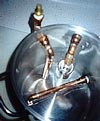beretta
Well-Known Member
- Joined
- Mar 8, 2008
- Messages
- 111
- Reaction score
- 6
During my last 2-3 batches I've gotten pretty lazy during my sparges. After about fifteen minutes of a regular english style sparge (after the grain bed settles), I simply opened the valve on my HTL, and emptied 3-4 gallons of sparge water into my MT. I ended up with about 7-8 inches of sparge water above the grain bed. It worked fine. Wort tasted correct, and my efficiency was around 85-89% (my usual). These beers aren't out of my pipeline yet, but soon I'll be tasting. It sure was easier than batch sparging or english sparging, but I'm wondering about the negatives. I thought the extra weight of the water might stick the mash, but it actually seems to make lauddering faster...Any thoughts?





































![Craft A Brew - Safale S-04 Dry Yeast - Fermentis - English Ale Dry Yeast - For English and American Ales and Hard Apple Ciders - Ingredients for Home Brewing - Beer Making Supplies - [1 Pack]](https://m.media-amazon.com/images/I/41fVGNh6JfL._SL500_.jpg)





















